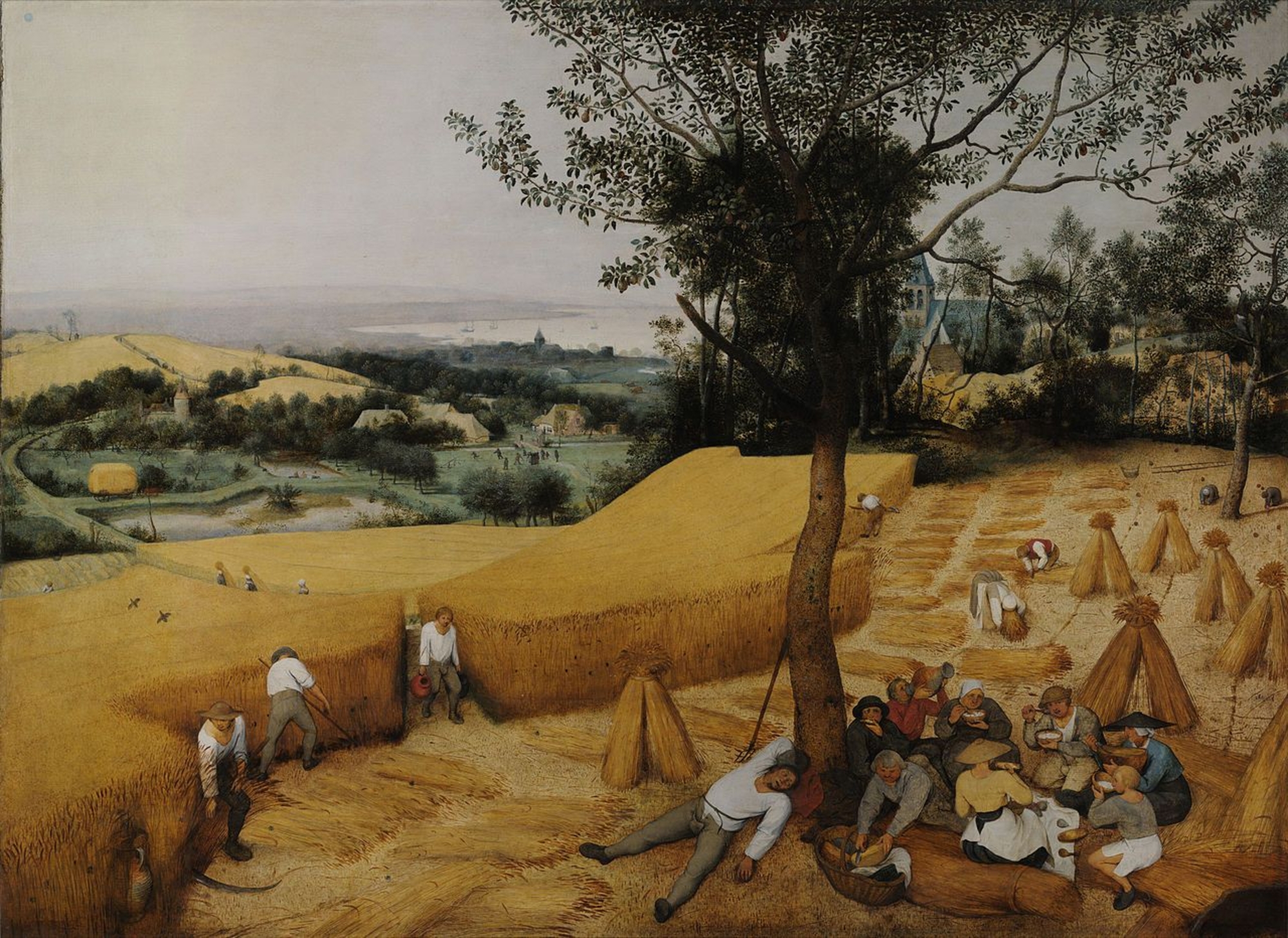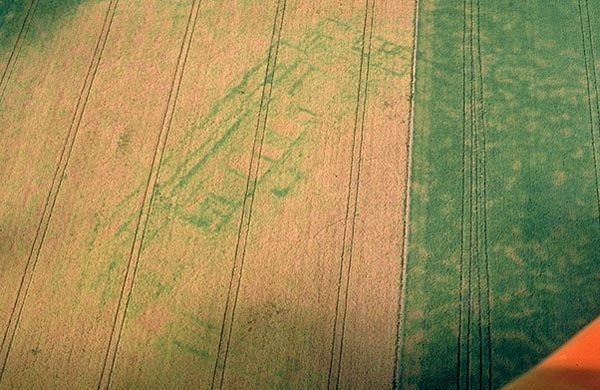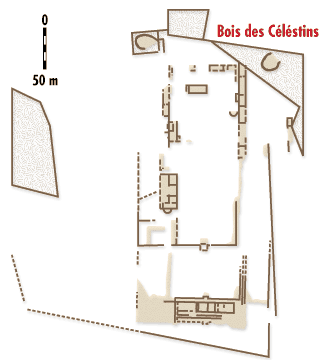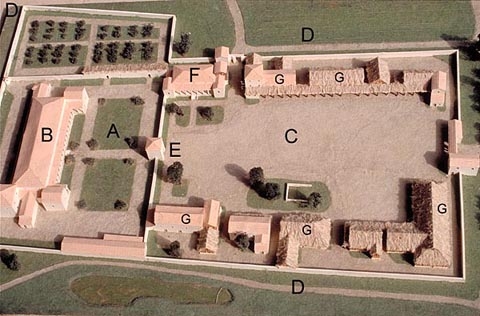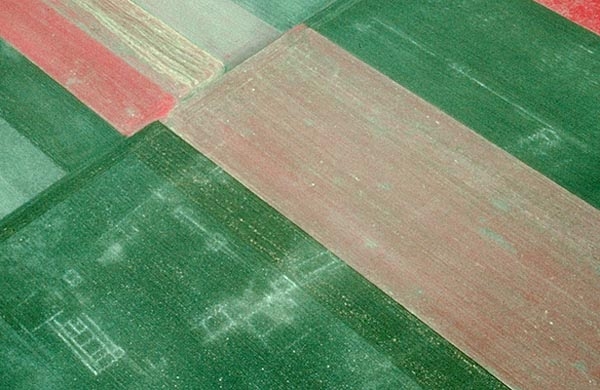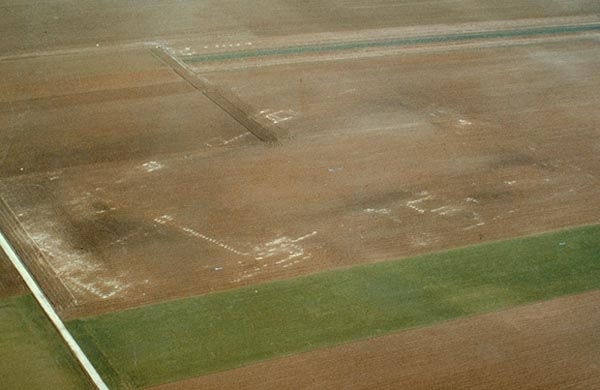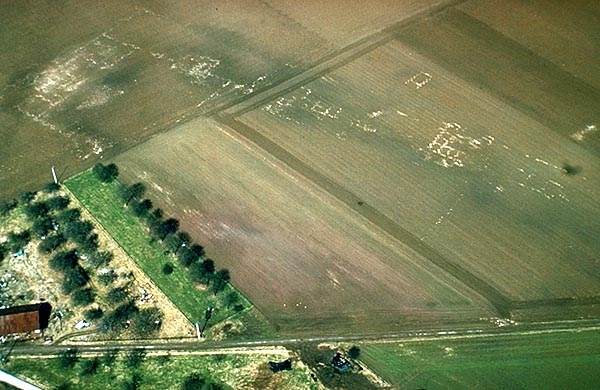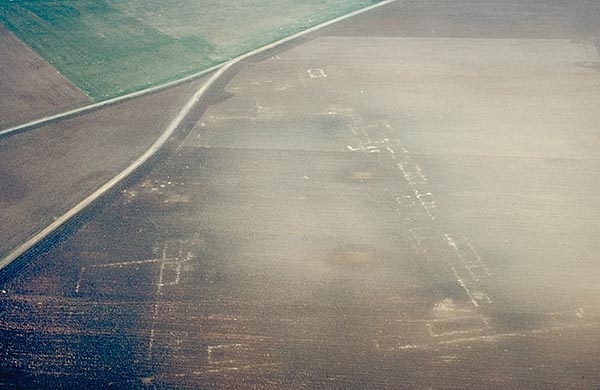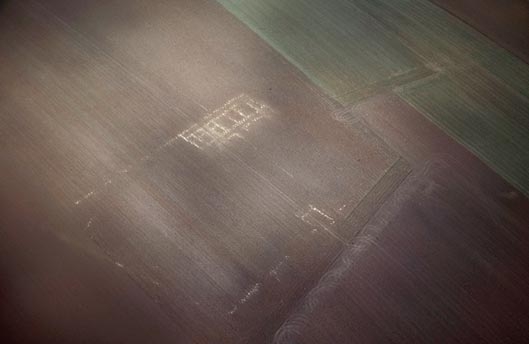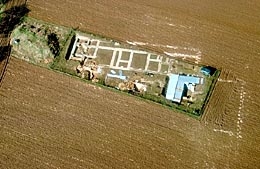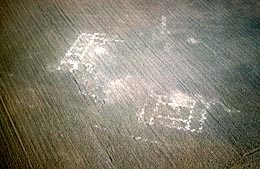- Home
- Discoveries
- Gallo-Roman settlements
- A typical Gallo-Roman villa
A typical Gallo-Roman villa
The villa at Estrées-sur-Noye (Somme) is characteristic of these vast rural establishments. Examining it, we are struck by the size and the monumentality of the principal habitation. Located at the rim of the plateau, facing the rising sun, it dominates the entire Noye valley. Seen from the air, this main building takes on very different appearances depending on the season.
Often, it is completely invisible. With the help of aerial photographs taken several years in a row, and thanks to deep plowing that rendered the foundation lines visible, the villa's basic layout was established on the ground. Although less extensive, it is very similar to the huge ensemble at Anthée in Belgium.
Overall view of the Gallo-Roman villa at Estrées-sur-Noye (Somme).
Same site: partial view of the main residence in summertime, among the crops. The locations of the foundations appear in green, and are a little clearer.
Same site, partial view of the main residence in wintertime.
Variations on a theme
In the fertile plains of the Artois or the Oise, we find establishments that are designed exactly like the one at Estrées-sur-Noye and sometimes much larger. This is the case at Francières-Hémévillers (Oise), where large parallel structures have been added to the pars urbana. The villa at Athies (Somme) is even larger but, at present, only the main residence has been excavated.
Among the great villas with imposing main residences, some, like the one at Warfusée-Abancourt nord (Somme), have a pars agraria that is shorter but wider, and of very elaborate design. In addition, several non-aligned buildings have been located well outside the villa, as Roman agronomists recommended for workshops dealing with odorous or dangerous materials.
There are also large, very long villas that are perfectly straight-sided, but with a more modest main residence, like at Cappy, Warfusée-Abancourt, and so on. The similarity of their layouts have allowed us to create a model, an attempt at reconstructing the basic form of these large rural structures from the early third century CE, taking into account the excavations at Estrées-sur-Noye (Somme). The presence of enclosing walls and abutting straight-sided enclosures is perfectly visible in photographs.
Francières-Hémévillers (Oise).
Infrared view of a large Gallo-Roman villa. Warfusée-Abancourt nord (Somme).
Model of a large Gallo-Roman villa characteristic of large farms in northern Gaul. H. Bernard (Abbeville Museum).
The Gallo-Roman villa at Estrée-sur-Noye (Somme) was used as a base for the model, following excavations led by R. Agache.
Nevertheless, there are a few slight variations to this basic layout. Sometimes, instead of having a rectangular shape, the two courtyards flare outward, taking on a somewhat trapezoidal form, while remaining perfectly geometrical and very large (Agache 1978 et Agache, Bréart 1975). The largest are those at Le Mesge (Somme), Ecoust-Saint-Mein (Pas-de-Calais), and especially the one at Lahoussoye (Somme), the only villa to have three successive courtyards.
A few large villas have overall layouts that are somewhat less regular, although their organization is very similar, like at Malpart (Somme), Daours-Vecquemont (Somme), and Vaux-sur-Somme. In most cases, this irregularity is the result of later modifications, destruction, and rebuilding.
If the plan of the villa at Belleuse (Somme) appears irregular, it is because this villa was reorganized or reconstructed at least three times. The doorway connecting the two courtyards has clearly been moved on three occasions. There are many examples of such modifications (Agache 1970 et 1978).
Le Mesge (Somme).
Ecoust-Saint-Mein (Pas-de-Calais).
Lahoussoye (Somme).
Malpart (Somme).
Flers (Somme).
Belleuse (Somme).
Small and medium-sized villas
Smaller-scale villas also exist. In nearly all of them, the overall layout is identical. Most are between 200 and 300 meters long. This length is already considerable. Others are 100 to 200 meters in length, which is still noteworthy. In these small and medium-sized villas, we find the two courtyards and almost always the two principal residences. When they can be observed, the outbuildings are arranged in the same fashion. In only 4 or 5% of cases, they are placed in no apparent order, but are these really villas?
Finally, there is what geographers call the "basic farm", that is, a house and a barn that face each other, but 75% of the villas located in the wheat fields are more than 200 meters long. It is true, however, that these structures are the least likely to escape the eye of the aerial prospector.
It is the largest villas that dominate the scene, even if they were enlarged gradually, and reached their full size by the early third century, as excavations show.
The villa is the very basis of Romanization, the fundamental victory of Rome, compared with the cities, whose too-ambitious development plans had to be partially curtailed. The villas — systematically built on the best land, following the directions of Roman agronomists as to their organization, orientation, topographical location, and two-courtyard layout — constitute the normal method for developing the land throughout this Galliarum planior.
It was the apogee and the apotheosis of large-scale rural structures in which, uncommonly, the farm buildings and the main residence (a veritable "chateau") formed a coherent whole, planned according to architectural principles, and just as much a monument to prestige as it was a source of revenue.
In contrast, in the rural chateaus of the seventeenth and eighteenth centuries, the seigneurial farm was pushed to one side, with buildings that were generally eclectic and disorganized. In Antiquity, the rural structures were magnified — they were part of the same global, perfectly geometric architectonic concept. All glory to the master. In the villa's monumental design, we can recognize the Roman tendency for ostentation, theatrical staging, and the search for effect. The countryside was thus embellished because, for Rome, beauty lay in mathematical order. There, as elsewhere, straight lines took the place of curves and Celtic tracery.
A basic farm at Pont-Remy (Somme).
Small villa with a gallery on one side. The main dwelling is hardly larger than the small modern house visible in the foreground to the right. Mercatel (Pas-de-Calais).
Church (14th century) and chateau (17th century) in the Somme.
The role of the villas
The extreme density of these villas, even through they are obviously not all contemporary, testify to a generalized presence throughout the fertile plains of northern France, as well as to a profound Romanization. The density and standardization of rural constructions attest to the extraordinary wealth and astonishing success of this Romanization — a success achieved less by constraint than by emulation.
We know from Tacitus, speaking of Britain, how the Romans sought to pacify the natives by giving them a taste for comfort and luxury, so that they might develop
"a liking for our style of dress, and often wear the toga … to allow themselves to be attracted by our vices, by a taste for the lounge, the bath, the elegant banquet…".
And Tacitus de concludes, "in their ignorance, the natives called this 'civilization', when it was but a part of their servitude" !
It was no doubt in this way that Rome managed to develop the region and supply the army and the populations of cities with the main foodstuffs that they needed. A number of clues lead us to think that these major cities had a semi-agricultural, semi-artisan nature, and that they basically produced wheat and wool, quite probably woven in the vast cellars that excavations have sometimes brought to light, such as at Athies (Somme).
Excavation of the main residence. The chalk foundations appear in fields that have recently been plowed. Athies (Somme).
Same site. A remarkable underground cellar with ornate apses and large, one-piece cellar windows. It appears to have served as a weaving workshop; the placement of the machines is visible in the masonry.
Large Gallo-Roman villa with an unusual layout at Roye-sur-Matz (Oise).
